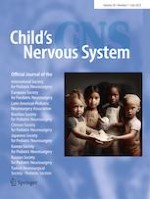Erschienen in:

02.05.2023 | Original Article
Pre and postnatal care characteristics and management features of children born with myelomeningocele in the post-folate fortification era of staple foods in Costa Rica (2004–2022)
verfasst von:
Adrian Caceres, Ana Laura Jimenez-Chaverri, Paula Andrea Alpizar-Quiros, Roy Wong-McClure
Erschienen in:
Child's Nervous System
|
Ausgabe 7/2023
Einloggen, um Zugang zu erhalten
Abstract
Purpose
To
describe the clinical characteristics of pre- and postnatal care of children born with myelomeningocele in Costa Rica from 2004 to 2022 after the introduction of mandatory fortification of four major staple foods, describing the clinical features of this cohort including the size of the meningomyelocele, neurological level, presence of symptomatic Chiari II at birth, kyphosis, and the severity of hydrocephalus requiring cerebrospinal fluid (CSF) shunting. These results were compared against the pre-fortification historical data to determine favorable outcomes from this health policy.
Methods
We performed a retrospective review of the clinical records of patients with myelomeningocele at the spina bifida clinic from the National Children’s Hospital of Costa Rica who were born between 2004 and 2022, a period when staple food fortification was implemented in the country for four food staples (wheat and corn flour, rice, and dairy products).
Pre and postnatal care data pertaining to the number of obstetric ultrasound studies, the trimester in which they were performed, the detection of myelomeningocele and associated hydrocephalus, gestational age and route of delivery, neurological level, myelomeningocele defect size, associated kyphosis and symptomatic Chiari II malformation at birth, time periods of myelomeningocele repair, and CSF shunting were examined.
A descriptive comparative frequency analysis between myelomeningocele (MMC) defect size, CSF shunt insertion, symptomatic Chiari II, and kyphosis between the different functional levels was performed with the estimation of the Fisher’s exact chi-square test by contingency tables, and 0.05 was set as significance level.
Additionally, the postnatal features of this cohort were compared against pre-fortification historical data obtained from 100 live-born patients between 1995 and 1996.
Results
A total of 215 patients that were live born between 2004 and 2022 were eligible for analysis with a follow up ranging from 1 to 19 years (median follow up: 7.9 years). Among 99.1% of the mothers of patients who had prenatal consultations, 95.8% had an average of 3.8 obstetric ultrasound studies which led to a 59% prenatal detection rate of myelomeningocele.
The pre and post fortification features showed a male/female ratio that changed from 0.92 to 1.25 respectively. Among these newborns, there was an increase from 54 to 64% cesarean sections as method for delivery. Only 26% of the pre fortification patients had the MMC defect repaired in the first 24 h, 32% from 24 to 72 h, 20% from 72 h to 1 week, and 22% later than 10 days respectively which deeply contrasted with the post fortification cohort where 7.5% had the MMC defect repaired in less than 8 h, 12.2% from 8 to 12 h, 66.5% 12–24 h, and 12.7% from 24 to 48 h and 1% later than 48 h, respectively (P < 0.01).
Regarding the post fortification myelomeningocele anatomic and functional characteristics, defect size was measured as less than 3 cm in 7% of cases, 3 to 5 cm in 50% of cases, 5 to 7 cm in 42% of cases, and greater than 7 cm in 1% of cases.
Thirteen percent of the cases had paraplegia due to a thoracic level, 10% had a high lumbar level, 58% had a middle lumbar level, 13% a lower lumbar level, and 6% only sacral compromise.
When the data from the pre and post fortification cohorts were adjusted and compared, there was a reduction from thoracic/high lumbar cases from 26 to 23% (P < 0.56), with an increase of middle lumbar cases from 43 to 58% and a reduction from 25 to 13% of low lumbar cases (P < 0.01) while there was no change in the 6% percentage of sacral cases respectively. Lesions that were considered too extensive or larger than 7 cm decreased from 7 to 1% while associated kyphotic deformities decreased from 6 to 1.4% (P < 0.01); symptomatic Chiari II malformation at birth also decreased from 7 to 2% in the pre- and post-fortification cohorts respectively with all these changes being statistically significant (P < 0.01). Seventy-nine percent and 80% of the pre and post FAF cohorts required CSF VP shunting with a mean time for insertion of 10 days after spinal defect closure with no significant statistical change between the two groups.
Conclusions
This study describes a four-staple folate fortified population of live-born patients with myelomeningocele lesions whose neurological level, defect size, and associated deformities such as spinal kyphosis and symptomatic Chiari II at birth suggest that folate fortification could have diminished the severity of this congenital disease.











